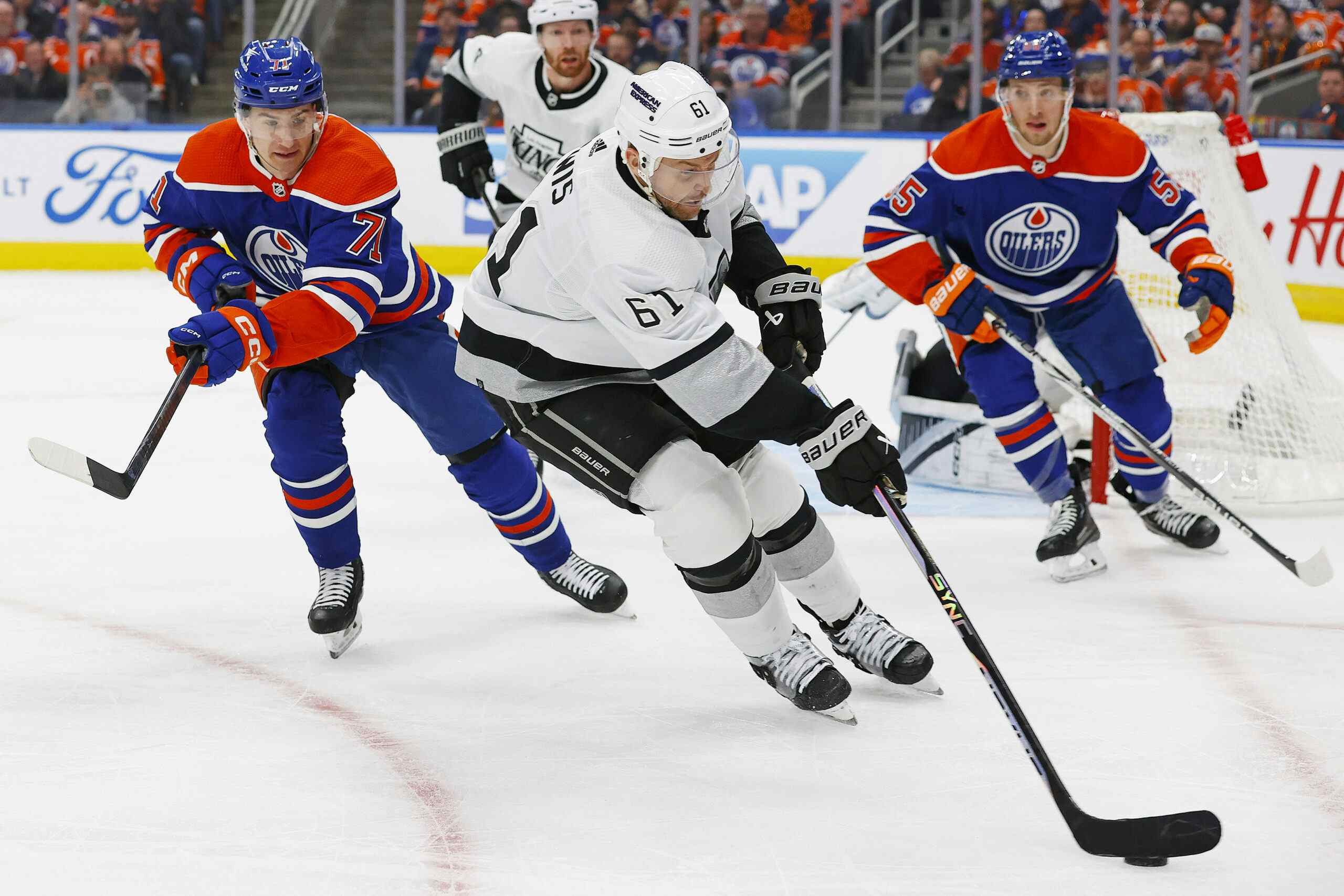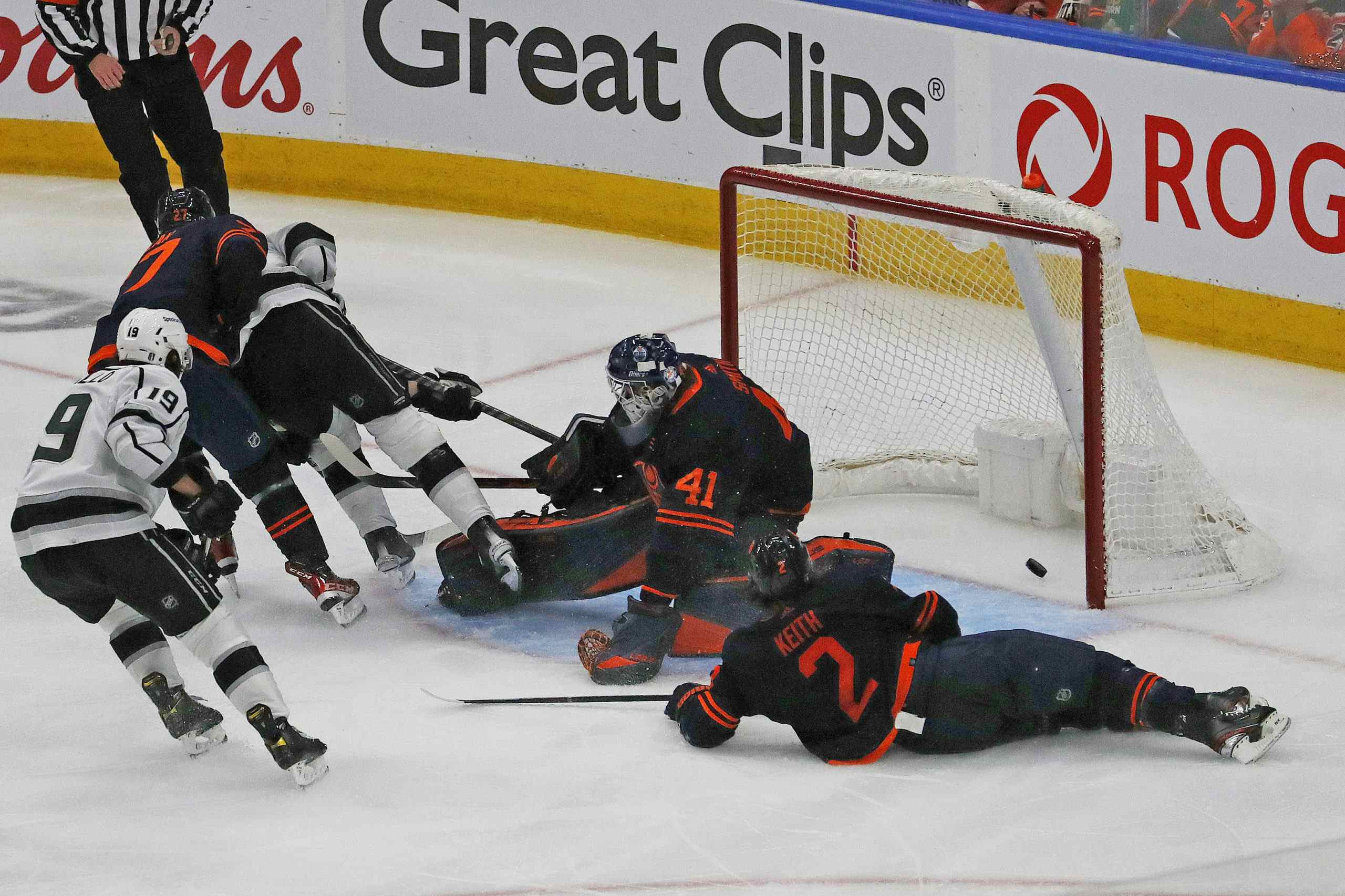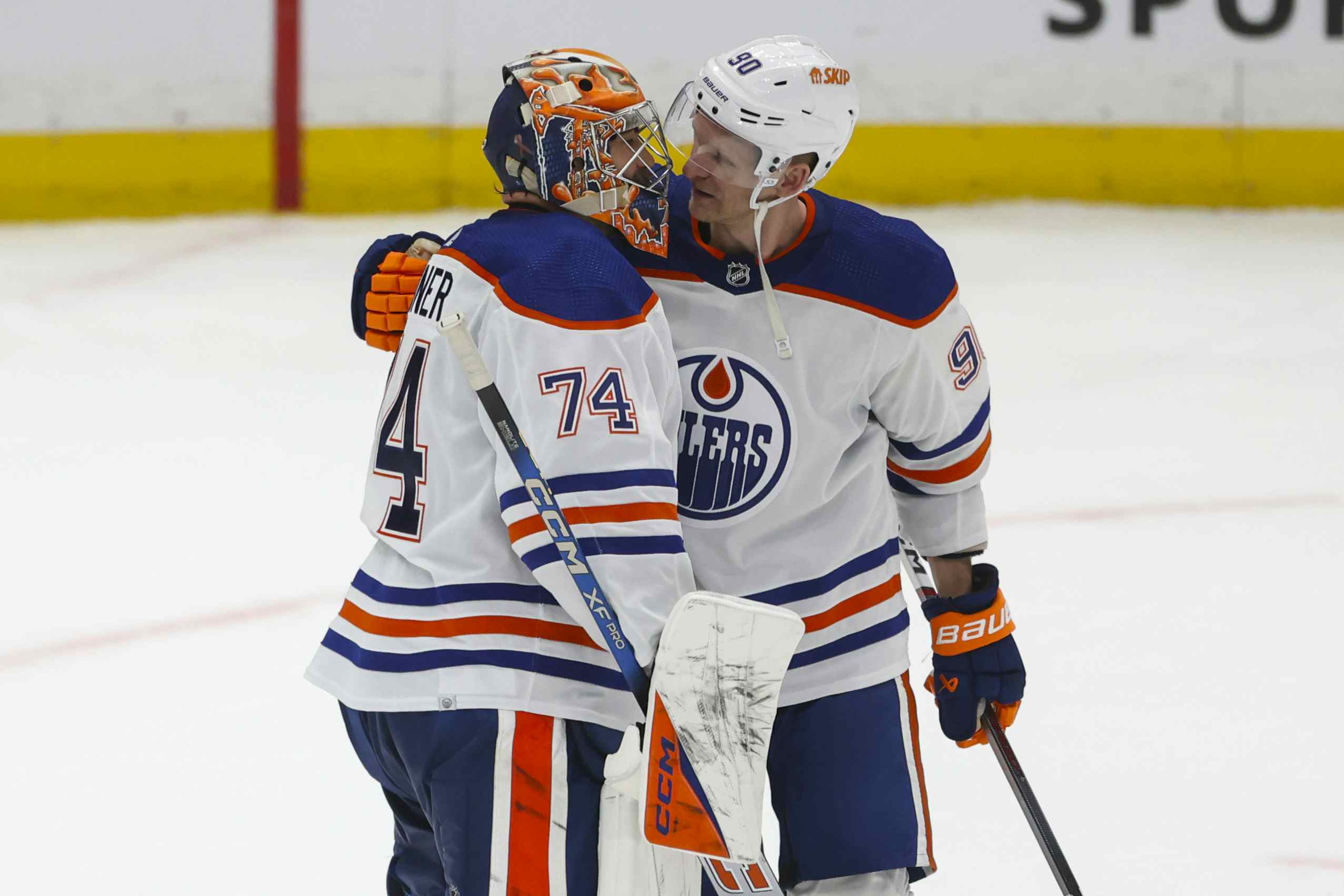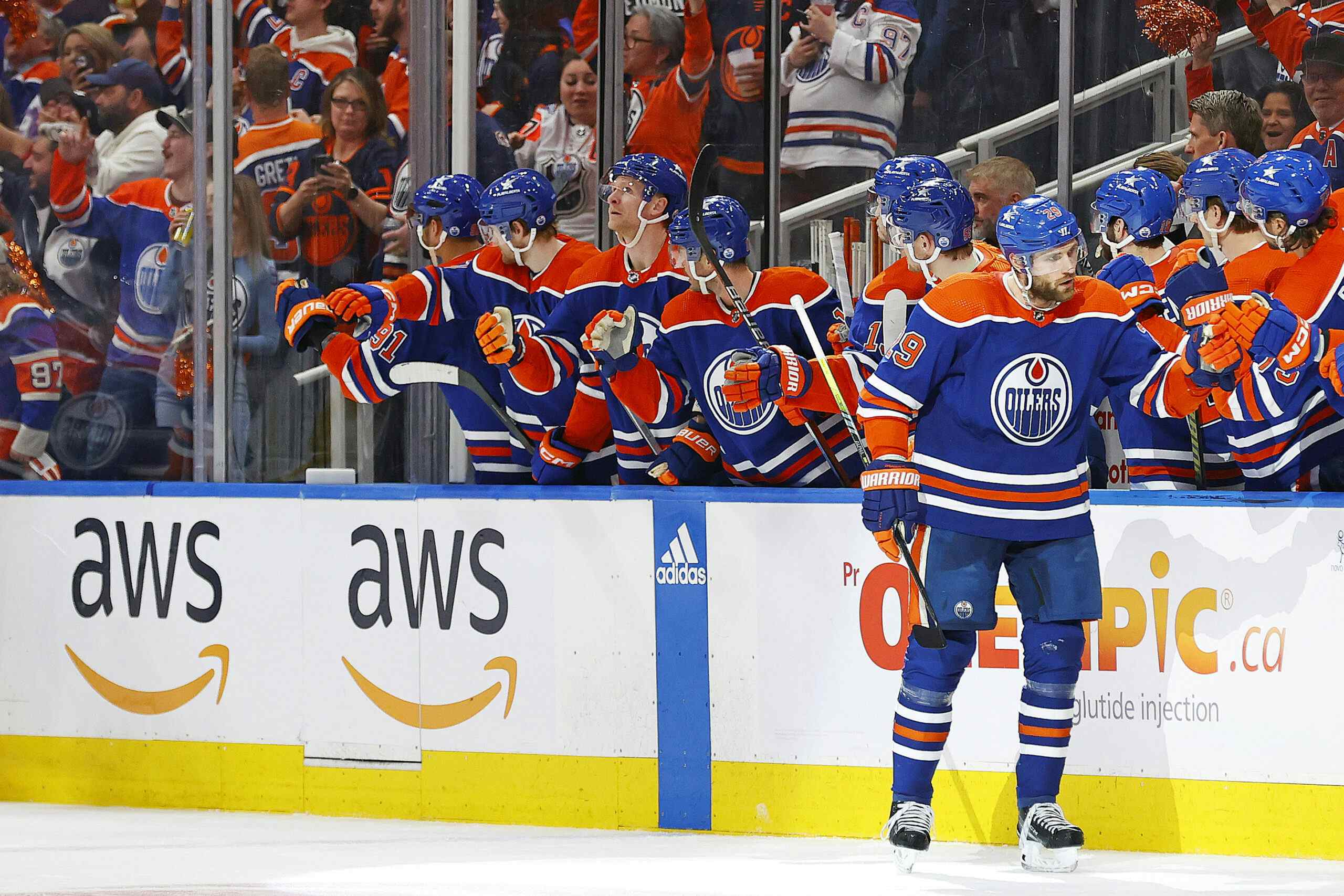Young Stars Tournament Day One: Oilers Disorganized

Photo by Darren Kirby
The Nations Network sent some Jets Nation writers to the Young Stars Tournament in Penticton, BC. They’re judging your team and bringing you the view from the Press Box.
Calgary had an impressive showing throughout the game, and it would be hard to imagine a more one-sided game through the first two periods. The Oilers struggled in transition and rarely created chances in the offensive end. Meanwhile, they failed to contain the Flames’ offence, and when Calgary wasn’t running a half-ice clinic, their transition chances seemed to be frequently of the 5-alarm variety.
In a prospect tournament, we’re primed to imagine the difference in team quality as being related to personnel. No doubt, many of the Oiler forwards looked out of place in the game. But in fact, the Oilers team struggles were very clearly linked to a single position – centre. Below we’ll review the game and the Oilers’ players.
Much of the Flames’ vertical offence came from a seemingly simple outside-inside layer attack in which the forward in the centre lane would float through the slot and wait for the pass out of the corner, or would burst ahead if the winger was held up at the line. In either case, the Flames seemed to be able to make that pass to an uncontested player in a dangerous area. Once the cycle was established, the Flames would still be able to find players in the low slot, frequently out-numbering the Oiler defenders in front or running a timing play with an attacking forward charging the net in time for a pass out of the cycle.
The plays are simple – perfect for a prospect tournament with little practice time – but Andrew Miller was the only Oiler centre who would track his check through the middle lane to the goal line and even he was inconsistent about the job. On one shift in the second period, Travis Ewanyk tracked his check to the goal line, but instead of stopping on the strong side in a passing lane, circled around the back of the net and then hit a player without the puck on the end boards where his defenceman already was while the Flames cycled to the point and flooded the shooting lane. The slot remained open, his strong-side winger confused.
Khaira had a strong offensive game, but frequently over-pursued in the offensive end, making his return to the d-zone a mostly effortful display for the coaches. Chase Schaber seemed to know his assignment, but was effectively short handed as with Brandon Baddock on his LW the Flames transitioned easily and quickly up the right boards.
With regard to broader systems, the Oilers were forced to play a dump and chase style, but seemed surprised at it regularly. When given the choice, the Oilers seemed to prefer to drive the corner and then re-group to the point with F2 tracking through the shooting lane. This was the case on the Khaira tip goal. In their own zone, the Oilers were obviously organized to have their centre support the low slot while the wingers played hash-marks to point, but this was rarely the case as centres pursued to the boards, floated high, or went below the goal line with impunity. If anyone had protected the slot, one might have thought it was by design.
On special teams the systems work continued to be very predictable. One interesting systems battle came on the Flames PP. The Oilers preferred a 1-3 PK neutral zone trap, but the Flames attempted to keep the Oilers flat-footed at their own blue line with a cherry picker. The Oilers countered by having the strong-side and middle lane player flood toward the cherry picker (i.e. move that direction with an angle on cutting off the play to that lane) while the weak-side player was ‘loose’ to prevent the Flames from making a pass to space or hitting the line with speed. Despite the score, the Oilers special teams were reasonably effective. Shortening the bench might have been the key to success.
Defence
The Oilers played with 6 left handed defencemen in the game, and it seemed almost as though it was the coach’s choice as to who would struggle. Marincin overcame the challenge, while Klefbom and Musil looked lost at times.
#34 Tyler Bunz – Bunz had a very challenging game to evaluate. He tracked the puck extremely well through traffic, showed good vision, and remained well-positioned and calm despite constant high-quality chances against. He tracks the puck well with his glove hand, and has that Niemi habit of catching across his body. However, he failed to track the puck all the way into his body and was frequently surprised by where the rebound went. In this game, the Flames had so many open chances that rebounds were hardly his first concern, but it could be a long tournament for him if he can’t start controlling his rebounds. He drew a penalty on Poirier by diving. Showed some professional flare with that play.
#74 Darnell Nurse: The first thing to notice about Nurse is his skating. He’s a big, big man, but it’s his transition and lateral skating that make him effective. His straight away speed is reasonable, and his skating in short bursts is very good. He was able to keep a close gap against the Flames, and his escapes were sharp all night. He is remarkably mobile and rarely needs to use his size. He’s effective with the puck and showed strong awareness while his partner switched sides all night. He did, however, struggle to read coverage and was rarely patient without the puck. (PS: the trip on Nurse in the third was really, clearly a trip. Tough break.)
#78 Martin Gernat: Gernat was among the most impressive and surprising players in the game to me. His work along the offensive blue line was by far the best in a game that included a host of highly rated defencemen. I believe all of his point shots were on net, of which there were many, and it was his line walk and shot that created the Khaira goal. He was one of few Oilers able to generate offence. He made one very confusing pinch to the offensive corner, and was clearly not a shut down defender with spacious gaps and not much desire to close out lanes. But his transition game was good and his coverage patient.
#80 Martin Marincin: Marincin had the best game of the Oilers defencemen to my eye, and his season in professional hockey showed very clearly. As an exceptional skater, his gaps were close and challenging, and he closed out lanes even on chip-in plays. His offence was patient and opportunistic. His lead passes were often long and it’s an open debate as to whether that was on him or the very confused Oiler forward group. Even on a poor pinch in the 2nd, he calmly used his leverage and power to tie up the Flames attacker and regain the puck.
#84 Oscar Klefbom: The challenge of playing a game with 6 left-handed defencemen is that someone will be uncomfortable. That was Klefbom. He forced the play at the blue line often, loved to make contact on the wing to close out forwards, but struggled with timing that hit on the right side, and couldn’t see his defensive coverage well from the right. He frequently chased the play into the left corner on rotation, from which he looked much more comfortable in transition. His decision making appeared strong, but he had limited support from the forward group and his timing on the right side caused a number of breaks.
#87 David Musil: I suspect there will be some disagreement with me on Musil’s game, but I thought he played well. Another victim of playing on his off-hand side, Musil wasn’t very noticeable after the first period save for two exceptional stick plays to break up the Flames offence. His speed was an issue at times, but in such a scrambled team effort, speed and quickness were more valuable than they would be in a more structured game.
#95 Ben Betker: I have to disagree with Bruce McCurdy’s rating of Betker. Though Betker was steady and maintained calm feet from one perspective, he also didn’t support Marincin well and showed limited range. His feet were heavy and his transition skating poor enough that he chose to give away the blue line to stay in front of players, and to stand in front of hte net when Marincin closed out lanes and created loose pucks in the corner. His awareness was nerve-racking as he failed to notice back-door plays, and even sometimes didn’t notice he was being checked. Betker was massive, but struggled to get his hands on anyone and rarely affected their play when he did. In the two shifts he shared with Brandon Baddock, his very loose gap became extremely problematic as the Flames forwards just walked in on his side of the ice without contestation. I thought he looked out of his league.
Forwards
The Oilers forwards were a very real problem for the team, and I believe their lack of centre experience and awareness was the reason for much of the disorganization we saw in the game.
#39 Brandon Baddock: Someone has to be the worst player in a game like this, and last night it was Baddock. His reads were very slow, so much that he was frequently behind plays that hadn’t even happened yet. When he was on the ice, the Flames made easy zone entries on his wing. He wasn’t even able to put his body on much as the play wizzed by him. He even circled into the passing lane of his own defenceman at one point after missing where he should be in the breakout.
#42 Marco Roy: Roy had 5 shots and looked active in the offensive zone. He had a stand-out 4×4 shift in which he broke early from the front of the net when he read a coming deflection, and then made a turning pass from the corner, across the zone to Darnell Nurse at the point. His awareness was obvious. But despite his offence, his impact on the game appeared limited.
#47 Ty Bilke: Part of the all-invite line that chased the play from start to finish. Limited PP time with Miller and Roy in the 3rd.
#49 Kale Kessy: Kessy loved to make contact but it was rarely effective contact as he continuously lost puck battles in spite of his apparent enthusiasm. He also showed heavy legs toward the end of the game and made an awful change with under 2 minutes left. He seemed to have little awareness for the play, and rarely generated offence.
#52 Austen Fyten: Mostly rode shotgun to Khaira, but also didn’t do much to cover for him when Khaira got over-zealous.
#54 Jujhar Khaira: Khaira was one of the few Oilers who was generating offence from down low. He drove the net, banged bodies to win pucks, and generally caused havoc for the Calgary defenders. It was obvious he’s a prospect of interest. He did, however, over-pursue the puck at times and was left stranded on plays in which Calgary was able to move the puck off their end wall. He may be used to hockey in which his physical skills are superior to those around him, or perhaps his college team played an offensive system in which the centre went low. In either case, his defensive coverage in transition was non-existent. Once the Flames had their half-court established, Khaira continued to over-pursue all the way to the side boards.
#58 Andrew Miller: The only Oiler centre to track his man through the slot, Miller was still not able to staunch the bleeding. His defensive coverage was inconsistent, and his offensive play better than most Oilers but hardly comparable to the best Flames. Real question marks exist about whether Miller is capable of NHL play this season. We can hope it was just a singluarly bad performance.
#61 Jackson Houck: The line of Houck/Ewanyk/Abney deserved more goals against, to be honest. Houck was the best player on it to my eye, and showed better footspeed than I expected. His first three strides are still slow, and he pursues the play as though it’s a game of keep away, frequently ignoring which side of the puck he should be on or where the passing lanes are. Showed some offensive sense.
#65 Chase Schaber: Schaber had a strong night on the penalty kill, and even took the face-offs when out with Miller. His two-way game was good enough for 5-2 loss, but he didn’t appear part of the solution.
#67 Travis Ewanyk: It was scrambling, choppy hockey with Ewanyk on the ice. His whole line made frequent contact, but did little to move the puck the right direction. Ewanyk often gave up his position to make a physical play, and the Flames were happy to let it happen.
#73 Cameron Abney: It gets hard to write about this line. On one play, Houck was hit near the benchs, so Abney crossed to the other wing to hit that player while Ewanyk skated in a straight line at the Calgary defender who had the puck. Two passes later, the Flames had a 3-on-2. He floated higher than the other RW in the defensive zone. He transitioned the wrong way in the neutral zone trap. He just flat out didn’t understand where to be.
#96 Gregory Chase: Chase had an impressive game, and I think did well if we were to track zone entries on the game. He protected the puck well and played a possession offensive game on a team with a lot of forwards whose skills are best suited to not having the puck. (Or maybe there not being a puck.)
Recent articles from Kevin McCartney





